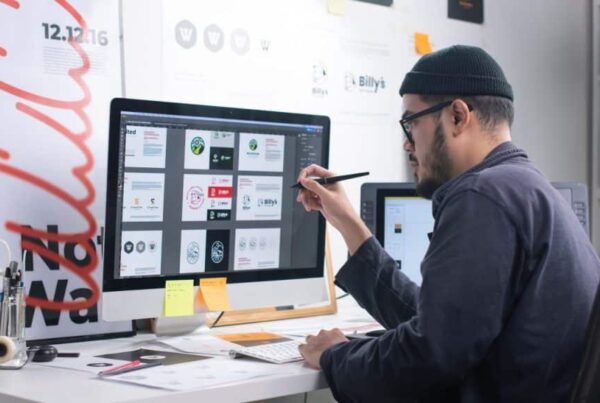Disclosure Sponsored Links: This post contains a paid-for sponsored link, meaning we have received compensation in exchange for including it. Sponsorship does not influence our content, but we believe in transparency regarding paid placements.
The art world is evolving rapidly, and there are now questions emerging about how artificial intelligence could be set to shake up the industry. The incredible technology has already shown its prowess in various areas, and now has the ability to produce complex visual works in a matter of minutes.
This has led to discussions about whether machines can create masterpieces in the same way humans can. There’s no doubt that their offerings are impressive, but can they be compared alongside works from humans that have required hours of graft? It may be useful to examine how art has advanced in the internet age and consider how AI art could fit into this picture in the future.
Table of Contents
The Current State of Art’s Evolution Online
The great thing about the internet has been the way that it has led to a multitude of new outlets for artists. While there may have initially been fear that digital art would replace traditional forms, the online world has merely added to the abundance of options in the industry. The same thing could happen with AI artwork as well, with it unlikely to replace human creation any time soon.
There have been countless innovations in art in the last couple of decades, with the thumbnail a great example of something that didn’t exist before computers. Now, there’s a massive market for thumbnail artwork, with key industries such as online casinos relying heavily on them. Scratchcards instant wins are designed to draw players’ attention, with options like Cash Squares and Crack the Code coming with highly appealing visuals. Thumbnails not only need to capture people’s interest, but also give them a taste of what to expect from the game. Therefore, their design has become a complex task for artists.
Memes and GIFs are other interesting new art forms that emerged for the first time in the internet age. The aim for their creators is to design something that is humorous or relatable, and that will appeal to a mass mainstream audience. Their designers want them to be quickly and widely shared, and the most successful ones can become viral. These offerings often take on meanings and can be used in comments and conversations online. As well as being entertaining, they can be a way to address social and political issues.
AI artwork is likely to be added to this ever-growing list of digital creations and could soon have its own place in the online realm. There will still be a need for thumbnails and GIFs, but AI could potentially assist in their development in the future.
AI in Art Creation: Technological Marvels
If someone had told you only a few years ago that AI would be creating works of art, you probably would have scoffed at them. But now, the technology is pushing the boundaries of what’s considered art. It’s able to analyse vast amounts of data, including works from past artists, and learn from it. Then, it can churn out original works that are often so complex that they surprise viewers.
There have already been a few high-profile AI art projects that have gained widespread attention. One of the most notable ones is Portrait of Edmond de Belamy, created by the Paris-based art collective Obvious. The project was made using a Generative Adversarial Network, which uses one neural network to generate the images and another one to evaluate them.
The offering was met with critical acclaim and sold for a whopping $432,500 at Christie’s auction house. Experts had estimated it to be worth around $10,000, so it completely shattered expectations. Another example of an AI art creator is Google’s DeepDream, which has the power to enhance and distort images to create surreal visuals. This has led artists to produce some unique pieces that challenge traditional aesthetic norms in the industry.
Despite its impressive displays so far, AI isn’t seen as a disrupter to the art community. Indeed, it’s more likely to act as a collaborative tool for artists rather than their replacement. It can provide humans with ideas about new techniques and styles, and one day may be able to offer feedback and suggestions for improvement.
Implications for Artists and the Art Community
Even though AI art is unlikely to replace the work of humans, there are questions about its role in the industry. Indeed, due to the fact that it can create stunning works, there may need to be some regulations in place to ensure that it doesn’t compete in the same realms as real creators.
It’s important to put protocols in place about the authorship of content that AI creates. When a machine produces a piece of art, is it the machine that’s the creator or the person who typed in the commands? Or would it go further than that and belong to the programmers who originally coded the AI? It could mean that when AI artwork is made, all of these contributors will have to be credited.
There are also ethical considerations when it comes to AI artwork. For instance, it’s hard to pinpoint issues of plagiarism and originality when it comes to content generated by machines. After all, these programs have been trained on creations made by real people. That means that when they produce their own works, they have been influenced by past offerings. If a machine is trained on copyright images, therefore, it may be hard to label the resulting artworks that it churns out as original.
There are plenty of positives with the introduction of AI art. The fact that it will make art creation more accessible to the masses is doubtlessly a good thing. Those without traditional artistic skill will have the chance to express their ideas, and this could lead to a richer and more diverse art landscape.
It’s clear that AI has the potential to create masterpieces, but it is unlikely to usurp human artists. Instead, it could act as a tool to help artists and make art more accessible to a greater number of people.








